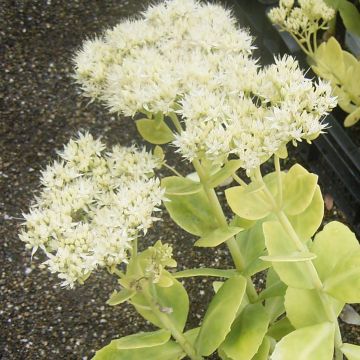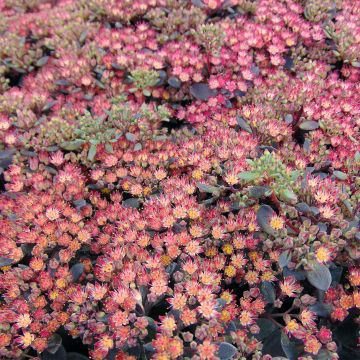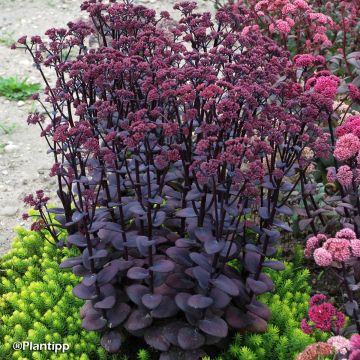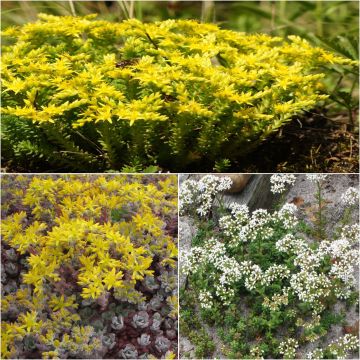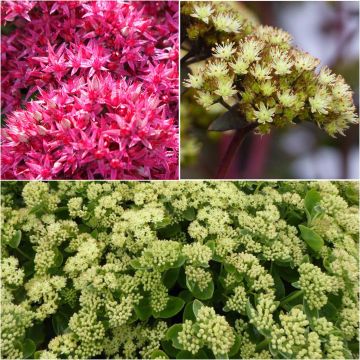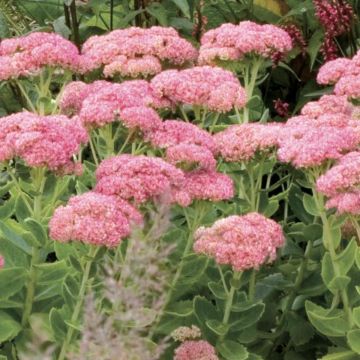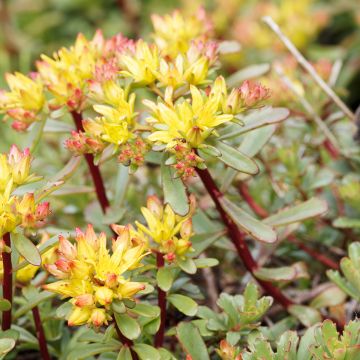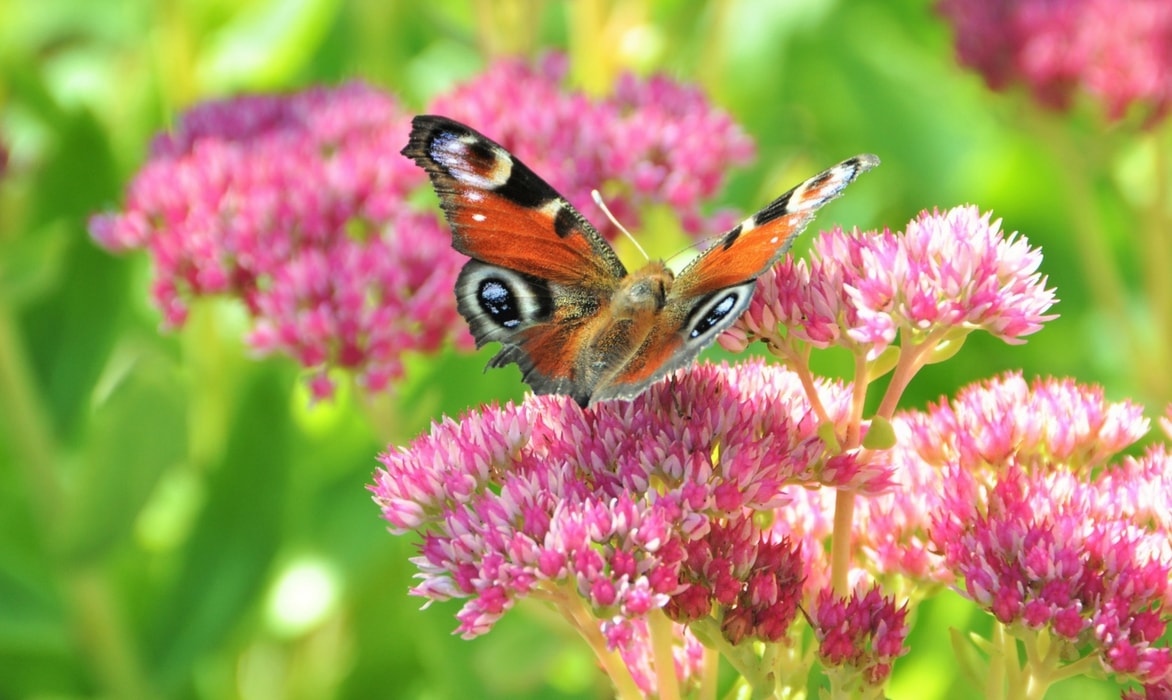
Sedum or Orpin: how to plant, cultivate and propagate them
Contents
Sedums in a nutshell
- Stonecrop is perfect for creating a low-maintenance dry garden! It grows quite well without fertiliser or watering, even in very poor soil.
- Its late flowering brings colour in early autumn, when the garden starts to lack flowers.
- The flowers of stonecrop offer a great diversity of colour. Discover the stunning pink flowers of Sedum spectabile, the yellow ones of Sedum reflexum, or the white ones of Sedum album!
- Grow upright varieties like Sedum telephium in borders or beds, and the spreading ones (Sedum spurium, Sedum reflexum…) as ground cover.
- Very robust, stonecrop offers exceptional resistance to drought and temperature fluctuations!
A word from our Expert
Sedum is an exceptional plant due to its drought resistance, tolerance to temperature fluctuations, as well as its resilience against diseases and pests. It is a plant that could be described as very self-sufficient. It manages on its own and thrives quite well even if the gardener neglects it! Cuttings are extremely easy to take. It has become the go-to plant for green roofs.
Very trendy, Sedum is becoming a preferred choice for creating urban gardens, green roofs, or water-efficient gardens. It addresses current concerns regarding ecology and urban gardening. Easy to cultivate, it fills the space left vacant by other plants in challenging areas with shallow soil, and allows for greening and adding colour to these places even in the middle of winter (for evergreen species).
This succulent plant offers a great diversity, both in its shapes and colours! Its habit can be upright or spreading, its flowers come in pink, white, or yellow, and depending on the varieties, its leaves can range from blue-grey, yellow-orange, to purple. It is possible to mix species to create a particularly colourful and varied display! The leaves often take on red or bronze hues in autumn, making them quite decorative, even after flowering has finished.
Sedum can be used in the composition of beds (such as Sedum ‘Matrona’) or borders, as well as in the creation of rockeries or green roofs. It can also add a splash of colour to an old stone wall!
Botany
Botanical data
- Latin name Sedum sp.
- Family Crassulaceae
- Common name Sedum or Orpin
- Flowering August to September-October
- Height 15 cm (spreading species) and 50 - 60 cm (upright species)
- Exposure Sun
- Soil type Draining, poor
- Hardiness -15 °C
Sedums have a wide distribution in the Northern Hemisphere. Many species can be found on the American continent, such as the beautiful Sedum palmeri from Mexico, or Sedum lanceolatum, which can be found in Canada and the United States. Sedums are also present in Asia, in eastern China with Sedum spectabile, and around the Mediterranean, such as Sedum album, passing through the Balkans and Carpathians. They are also found in North Africa.
Sedum belongs to the family of Crassulaceae, which includes around 1,500 species of predominantly succulent plants. This family includes Kalanchoes, Crassula, and houseleeks. These succulent plants, commonly referred to as “fat plants“, have adapted to life in arid environments by storing water in their tissues, giving them a “plump” appearance. Their metabolism makes them particularly suited to drought. Their stomata (organs regulating gas exchanges) open at night, when temperatures are lower, and close during the day, which helps prevent water loss.
There are over 400 species of Sedums, along with many varieties. They are very close to the genus Hylotelephium, which is sometimes used as a synonym for Sedum. In France, about thirty species can be found, including Sedum acre, Sedum rupestre, or Sedum album, which generally grow on walls, in rockeries, or dry meadows, in sunny locations.
Two main categories of Sedum can be distinguished:
- Small creeping Sedums, with a spreading habit. They conform to the shape of the ground and often measure 10 to 15 cm in height. During flowering, they create beautiful carpets of small star-shaped flowers in yellow, pink, or white. This is the case for Sedum acre or Sedum spurium. Most of these Sedums are used in green roofs. Their leaves are often small, elongated, and evergreen. They can take on various colours (purple, yellow, red, green…), making them remarkably decorative.
- Large upright Sedums. This includes Sedum spectabile, which can reach 60 cm in height under good growing conditions. They are primarily used in borders and beds. They typically have broad, flat, dentate leaves.
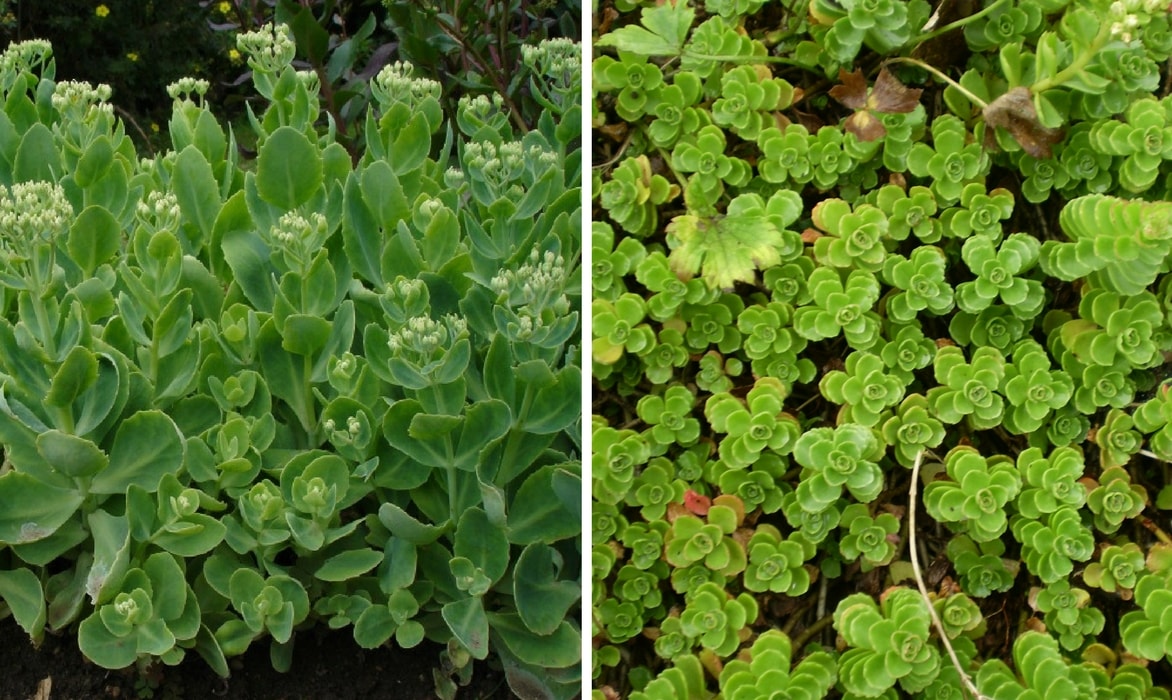
Sedum spectabile, – Sedum spurium album: two very different habits
The flowering generally appears late, starting in August. It is so generous that creeping Sedums sometimes seem to disappear under a carpet of flowers in vibrant colours! On upright Sedums, the flowers are grouped in dense, flattened inflorescences. Even after flowering, the dried inflorescences remain decorative due to their shape.
The flowers take the form of small stars. They typically have five petals, five sepals, and ten stamens. The flowering can be white, pink, or yellow. The shades of pink vary, with the colour being more or less pronounced and almost reaching red (Sedum ‘Dragon’s blood’)! The flowers, particularly those of Sedum spectabile, are melliferous, attracting butterflies and bees with their nectar.

Sedums ‘Sunkissed’ – ‘Carl’ – ‘Sunsparkler Lime-Zinger’

Sedum ‘Eline’ – Sexangulare – ‘Touchdown’
The leaves of Sedum also come in various shapes, but are always fleshy and relatively thick. Indeed, Sedum is a succulent plant (or “fat plant”): its leaves allow it to store water to withstand drought. Their shape varies: they can be broad and flat, as in Sedum spectabile, or small and imbricate as in Sedum acre, or even cylindrical and elongated as in Sedum album. The leaves of Sedum spectabile measure 10 cm in length, compared to only 3 mm for Sedum acre!
The leaves of most creeping Sedums are evergreen or semi-evergreen, meaning the plant retains its foliage in winter if conditions are mild. Those of upright varieties, such as Sedum spectabile, are generally deciduous.
There is a great diversity in the colours of the foliage! There are varieties with silver foliage (Sedum spathulifolium ‘Cape‘Blanco’), burgundy (Sedum ussuriense ‘Turkish Delight’), bicolour, or even tricolour (Sedum spurium ‘Tricolor’)! More generally, the leaves tend to change colour depending on conditions: they can turn red due to water stress or simply when autumn arrives. This quality deserves to be exploited. By combining various species, a patchwork effect with many colours can be achieved!

Foliage: Sedum album Coral Carpet – Sedum Red Cauli – Sedum reflexum Angelina – Sedum spathufolium purpureum – Sedum tetractinum Ogon
The roots of Sedum are shallow, making it particularly suitable for green roofs. It can thus grow with little substrate. This is why it is found in nature on walls, roofs, rocks, cliffs… It requires very little!
Sedum is a remarkably resilient plant. It generally tolerates both very low and very high temperatures. Many species are hardy down to –15 to –20 °C. It requires sun and good drainage. Indeed, it does not tolerate stagnant moisture, which can cause its roots to rot. It is wind-resistant and copes well with salt spray.
Sedum has medicinal properties, particularly Sedum spectabile. In case of an insect sting, take a small leaf, remove the skin layer, and rub it on your skin. It will quickly relieve the injury. Its juice promotes the healing of wounds, soothes burns, inflammation, warts, and haemorrhoids.
Sedums used as ground cover, such as Sedum acre, can almost replace lawns. Areas with shallow, dry soil and sunny exposure can thus be easily greened! This explains why Sedum is so commonly used for greening roofs.
Read also
How to create a green roof?Species and Varieties
There are over 400 species of Sedum, and horticulturists have created countless varieties. Twenty-eight of them have been awarded the Award of Garden Merit by the Royal Horticulture Society (RHS).
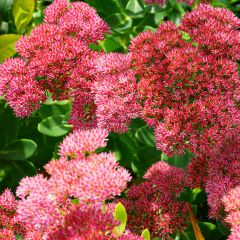
Sedum Herbstfreude - Autumn Stonecrop
- Flowering time September to December
- Height at maturity 50 cm
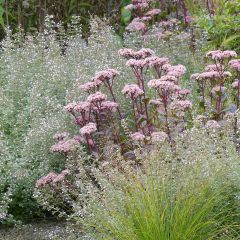
Sedum Matrona - Autumn Stonecrop
- Flowering time September to November
- Height at maturity 60 cm
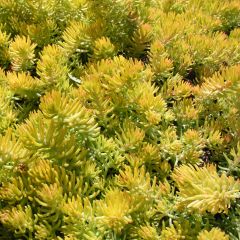
Sedum reflexum Angelina - Stonecrop
- Flowering time July to September
- Height at maturity 15 cm
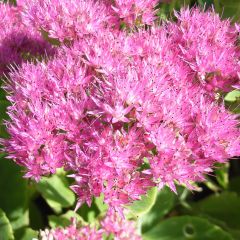
Sedum spectabile Carmen - Autumn Stonecrop
- Flowering time September to November
- Height at maturity 50 cm
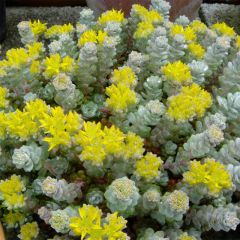
Sedum spathulifolium Cape Blanco - Stonecrop
- Flowering time June, July
- Height at maturity 5 cm
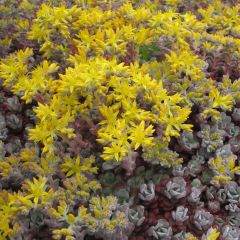
Sedum spathulifolium Purpureum - Stonecrop
- Flowering time September, October
- Height at maturity 10 cm

Sedum ussuriense Turkish Delight - Stonecrop
- Flowering time September, October
- Height at maturity 15 cm
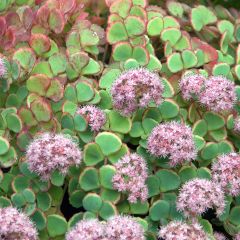
Sedum sieboldii - Stonecrop
- Flowering time October, November
- Height at maturity 15 cm
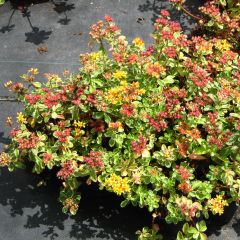
Sedum kamtschaticum Variegatum - Stonecrop
- Flowering time July to October
- Height at maturity 10 cm

Sedum spurium Album Superbum - Autumn Stonecrop
- Flowering time July, August
- Height at maturity 10 cm
- Sedum acre
Commonly known as Wall Pepper, this small Sedum offers a lovely yellow flowering, bright and cheerful. An excellent ground cover, it spreads easily to form a carpet of yellow flowers. It is one of the smallest Sedums! It has tiny imbricate leaves, sometimes tinged with red. It is hardy down to -15 °C. It can be found in France in the wild, on walls and roofs of houses in sunny locations. Thus, it will be very suitable if you install it on a green roof, on a low wall, or in a pot.
- Sedum spurium
This species, native to the Caucasus, grows quite slowly but spreads easily to cover the ground with a carpet of green leaves. It remains rather low and offers a lovely starry flowering, pink more or less reddish in summer. The leaves are evergreen, green with hints of red. They are flattened and arranged in two ranks around the stem. This species, very hardy, tolerates slightly shaded exposure. Use it as ground cover or in green roofs.
- Sedum spectabile
Sedum spectabile or Autumn Stonecrop is part of the species with an upright habit, thus it is much taller than the spreading Sedums. It is particularly beautiful in autumn! From the end of summer, it bears large terminal inflorescences, composed of starry pink flowers. Some varieties, such as ‘Stardust’ or ‘Iceberg’, have white flowering. These flowers are very melliferous and attract butterflies with their nectar. Its straight stems bear broad, grey-green and deciduous leaves. This species is native to China and Korea, and it is sometimes marketed under the name Hylotelephium spectabile.
- Sedum album
Sedum album is a small plant with slow growth and a spreading habit. In mid-summer, it bears lovely white starry flowers in clusters. Its small, cylindrical leaves sometimes turn red, particularly during dry periods. In France, it can be found in the crevices of low walls, on rooftops, or on rocks. Its small size and spreading habit make it easy to use in green roofs.
- Sedum reflexum
Rock Stonecrop is a small Sedum with a spreading habit. It is often found under the name Sedum rupestre. It grows quickly and spreads to form a carpet of green leaves, turning red-orange in autumn. Its leaves are evergreen and give this plant the appearance of small spruce branches. It offers a delicate bright yellow flowering in summer. It is hardy down to -15 °C and is commonly used in green roofs. There are cristate forms (due to a growth anomaly causing flattened shapes), which thus produce very original plants! (Sedum reflexum ‘Cristatum’)
Discover other Sedum
View all →Available in 0 sizes
Available in 1 sizes
Available in 1 sizes
Available in 2 sizes
Available in 3 sizes
Available in 0 sizes
Available in 2 sizes
Available in 0 sizes
Available in 1 sizes
Available in 1 sizes
Young plantation
Where to plant?
The planting location depends on the type of Sedum you have chosen. Thus, if you are planting a tall variety with an upright habit, install it in a border or as part of a mass planting. However, if you have chosen a small creeping Sedum, you can place it in a rockery, on a walls, on a paving, or on a green roof. You can also choose to plant your Sedums in pots, creating a composition by combining various species. Since Sedums have very shallow roots and often have a creeping habit, choose a pot that is wide enough and shallow. This will prevent your plants from becoming too cramped.
Sedum requires direct sunlight. It will thrive if you place it against a wall facing south. It also needs very well-drained, dry, and porous soil. If the soil is heavy, add gravel or coarse sand to facilitate drainage. It can even be slightly calcareous, but it should not be too rich. Sedum tolerates wind and salt spray very well.
Discover Sedums in video:
When to plant?
We suggest planting Sedums in spring, starting from April. However, planting is also possible in autumn if your soil is well-draining and the climate is mild enough.
How to plant?
- Planting in the ground
Start by moistening the root ball. Then, dig a planting hole. Feel free to add a layer of gravel at the bottom to aid drainage. You can also mix sand with the planting soil. Put some substrate back in the bottom of the hole and place the root ball. Fill in the hole, making sure not to bury the collar (base of the main stem). On the contrary, the plant can be slightly elevated above the soil level, which will prevent water from pooling in winter. Firm the soil gently around the Sedum with the palm of your hand. Water. We recommend covering the soil with a light layer of gravel, both for aesthetic purposes and to facilitate the establishment of the Sedum.
If it does not rain, continue to water regularly for the first few weeks after planting. This will help the Sedum establish itself and begin its development. After that, it will manage without watering.
Small, creeping Sedums benefit from being planted in groups (at least five plants together). Feel free to mix varieties; this will create a very colourful carpet, both in terms of foliage diversity and flowering.
For larger varieties, such as Sedum spectabile or Sedum ‘Matrona’, maintain a planting distance of 50-60 cm. For smaller ones, like Sedum acre, 15-20 cm is sufficient. Planting is simpler for these small, creeping species. You can simply dig a small hole and lightly bury the root ball.
- Planting in pots
Soak the root balls in water and create a substrate made up of half sand and half potting soil.
Choose a container that is wide enough. At the bottom, place a layer of gravel, perlite, or clay balls to ensure drainage and prevent water stagnation. Then add the substrate. Plant, and then gently firm the soil around each plant. Water to encourage the establishment of the Sedum.
→ Learn more about growing Sedum in pots in our advice sheet!
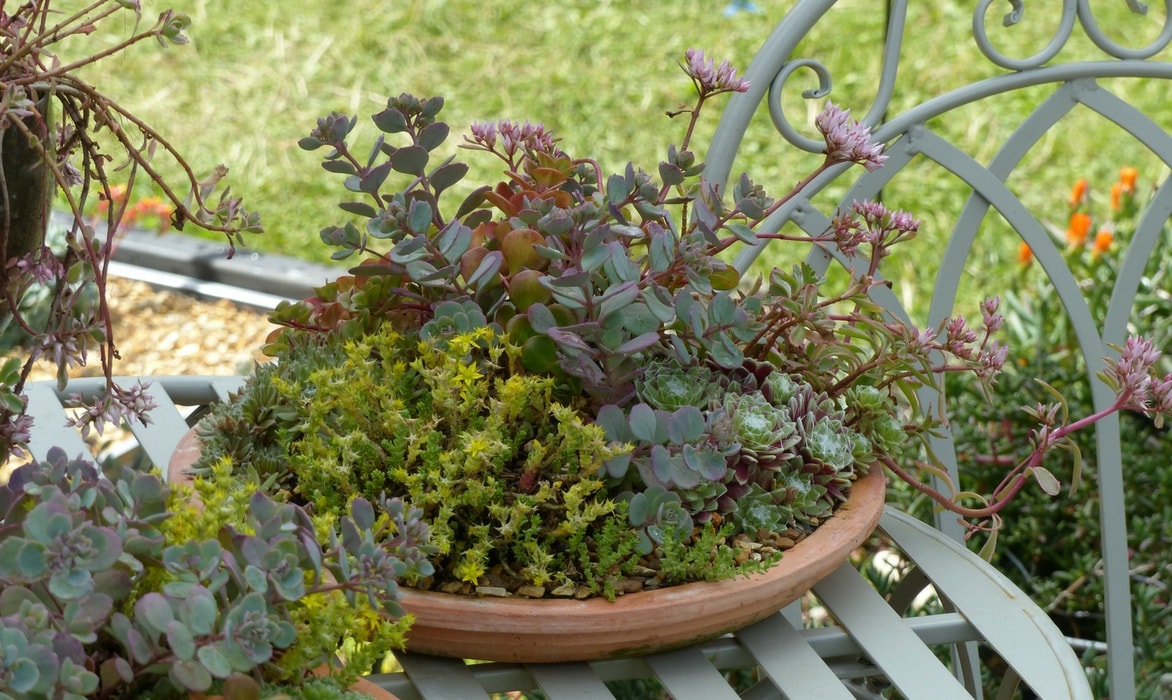 A lovely composition in a simple clay saucer
A lovely composition in a simple clay saucer
Maintenance
Sedum requires almost no maintenance. Perfectly drought-resistant, it generally does not need watering. However, if it is planted in a pot and receives little rain, you can water it very moderately. Sedum also has low nutritional needs, thriving in poor soils, and fertiliser applications are unnecessary. Watering, like fertilising, could instead make it taller, less compact, and more fragile.
It is rarely attacked by pests or parasites, except for gastropods (snails and slugs) and caterpillars, which may nibble on the leaves. If you grow your Sedums in pots, their roots may be attacked by vine weevils (Otiorhyncus sulcatus). However, these attacks are quite infrequent, and Sedum is generally resilient. The only point to monitor is the risk of root rot if the environment is too damp.
We recommend cutting back the clump in early spring using pruning shears, removing dry stems and faded flower spikes.
If you have planted your Sedums in pots or bowls, you can leave them in place for several years without needing to repot.
Multiplication
Sedum, like most succulents, propagates naturally by vegetative means, from a simple leaf or stem touching the soil. Propagation by cuttings is therefore very easy. You can also propagate it by sowing or clump division. If you leave the faded flowers, Sedum will tend to self-seed naturally.
Sowing
Sow Sedums preferably in spring. The fineness of the seeds makes the operation a bit delicate, less easy than for other species.
The seedbed must therefore be very fine, as the seeds are small. Mix them with sand to facilitate sowing and arrange them as evenly as possible. Do not cover them with soil, but you can lightly firm them to ensure they are in good contact with the substrate. Place the pot in a bright location and at a temperature between 20 and 25 °C. Water gently from time to time. The seeds will germinate in a few weeks.
Clump division
You can divide your Sedums every 3 to 4 years. This should be done in spring, around March.
For tall and upright varieties, you can cut them back to reduce their height. This will make the operation easier and help the plant cope with the process. Dig wide enough around the base. Carefully remove the plant from the soil, preserving as many roots as possible. Separate the plant, keeping enough healthy roots. Immediately place the plant in its new location. Water.
Propagation by cuttings
Propagation by cuttings of Sedums is very easy to carry out, as some species naturally tend to develop roots as soon as a stem touches the soil. This operation should preferably be done at the end of spring, before the plant flowers.
Two types of cuttings are possible:
- Leaf cutting
Prepare a pot by filling it with a mix of potting soil and sand. Place a thin layer of sand on the surface to prevent water stagnation. Take a few leaves, detaching them cleanly from the mother plant. We recommend letting them dry in the shade for a few days. This will reduce the risk of rot. Place the leaves on the substrate. There is no need to bury them.
- Stem cutting
Take a stem about 10 cm long, cutting it cleanly just below a node (the point of intersection between the stem and the leaves). Remove the leaves at the base. Replant the stem in a substrate made of a mix of potting soil and sand, pushing it in slightly. Gently firm the soil around the stem. Water and wait. The cutting will develop new leaves and roots in a few weeks.
When the plant is sufficiently developed, you can repot it.
→ Learn more with our tutorial: How to propagate Sedums?
Association
Sedums offer such a diversity of shapes and colours that numerous combinations are possible! It is essential to choose plants that have the same needs: dry, well-draining soil, and sunny exposure. Generally, rock garden plants or alpine plants are very suitable: stemless Gentians, Campanulas, Helianthemums, or Saxifrages. Houseleek (Sempervivum) is a plant that pairs well with creeping Sedums! If you choose to plant your Sedums on a wall, you can combine Sedum album or Sedum spurium with Campanula muralis!
Sedum can also easily integrate into a Mediterranean garden, dry and predominantly mineral. It will pair well with Lavenders, Thymes, or Santolines. You can add some elegant grasses: they will bring lightness alongside the Sedums, whose foliage is more substantial.
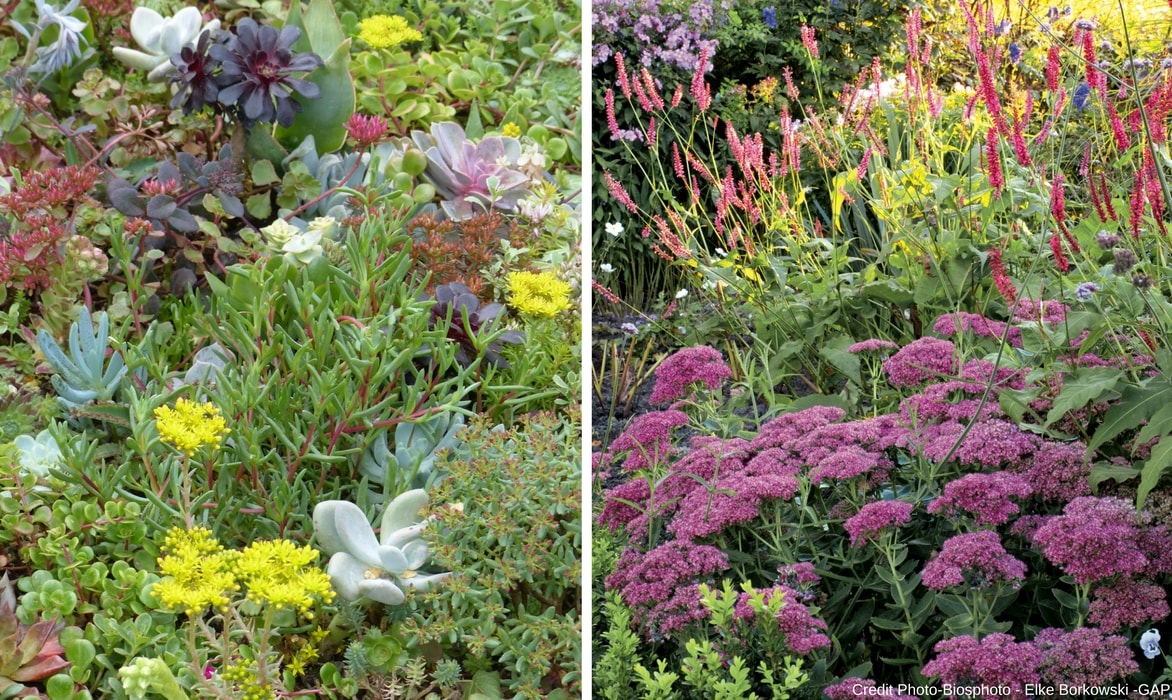
Two examples of Sedum associations
Useful resources
- Our wide range of Sedums
- Our tutorial on creating a green roof
- Subscribe!
- Contents

































